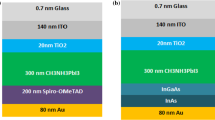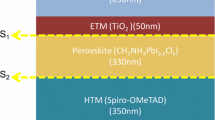Abstract
Hole transporting layer (HTL) free organometal halide perovskite solar cells have shown great promise in simplifying device architecture, fabrication process and enhancing stability. However, the simple elimination of the HTL from the standard sandwiched configuration suffers from relatively poor device performance; additionally, the mechanism of the HTL-free perovskite solar cell is still unclear. Herein, we applied a one-dimensional modeling program wxAMPS to investigate the planar HTL-free perovskite solar cells by adjusting the absorber thickness, doping and the absorber/back contact band alignment. The simulation results reveal the importance of the moderate absorber thickness as well as the p-doping perovskite rather than intrinsic as in sandwich structure to the overall device efficiency. In the meanwhile, reducing the mismatching of the absorber/back contact by using higher work function back contact material in replacement of commonly utilized Au electrode is more favorable to improve the device performance. Through optimizing, high performance HTL-free perovskite solar cell with efficiency approaching 17% could be achieved. This study is helpful in providing theoretical guidance for the design of HTL-free perovskite solar cells.
Similar content being viewed by others
References
http://www.nrel.gov/ncpv/images/efficiency_chart.jpg (Available 2016 August)
Wei D, Wang T, Ji J, et al. Photo-induced degradation of lead halide perovskite solar cells caused by the hole transport layer/metal electrode interface. J Mater Chem A, 2016, 4: 1991–1998
Lu H, Deng K, Yan N, et al. Efficient perovskite solar cells based on novel three-dimensional TiO2 network architectures. Sci Bull, 2016, 61: 778–786
Zhang J, Barboux P, Pauporté T. Electrochemical design of nanostructured ZnO charge carrier layers for efficient solid-state perovskite-sensitized solar cells. Adv Energy Mater, 2014, 4: 1400932
Nguyen WH, Bailie CD, Unger EL, et al. Enhancing the hole-conductivity of spiro-OMeTAD without oxygen or lithium salts by using spiro(TFSI)2 in perovskite and dye-sensitized solar cells. J Am Chem Soc, 2014, 136: 10996–11001
Chen B, Yang M, Priya S, et al. Origin of J–V hysteresis in perovskite solar cells. J Phys Chem Lett, 2016, 7: 905–917
Li Y, Ye S, Sun W, et al. Hole-conductor-free planar perovskite solar cells with 16.0% efficiency. J Mater Chem A, 2015, 3: 18389–18394
Laban WA, Etgar L. Depleted hole conductor-free lead halide iodide heterojunction solar cells. Energy Environ Sci, 2013, 6: 3249–3253
Shi J, Luo Y, Wei H, et al. Modified two-step depositionmethod for high-efficiency TiO2/CH3NH3PbI3 heterojunction solar cells. ACS Appl Mater Interf, 2014, 6: 9711–9718
Tsai KW, Chueh CC, Williams ST, et al. High-performance holetransporting layer-free conventional perovskite/fullerene heterojunction thin-film solar cells. J Mater Chem A, 2015, 3: 9128–9132
Liu Y, Sun Y, Rockett A. A new simulation software of solar cells—wxAMPS. Solar EnergyMater Solar Cells, 2012, 98: 124–128
Minemoto T, Murata M. Device modeling of perovskite solar cells based on structural similaritywith thin film inorganic semiconductor solar cells. J Appl Phys, 2014, 116: 054505
Liu F, Zhu J, Wei J, et al. Numerical simulation: toward the design of high-efficiency planar perovskite solar cells. Appl Phys Lett, 2014, 104: 253508
De Wolf S, Holovsky J, Moon SJ, et al. Organometallic halide perovskites: sharp optical absorption edge and its relation to photovoltaic performance. J Phys Chem Lett, 2014, 5: 1035–1039
Ahn N, Son DY, Jang IH, et al. Highly reproducible perovskite solar cells with average efficiency of 18.3% and best efficiency of 19.7% fabricated via lewis base adduct of lead(II) iodide. J Am Chem Soc, 2015, 137: 8696–8699
Wojciechowski K, Saliba M, Leijtens T, et al. Sub-150°C processed meso-superstructured perovskite solar cells with enhanced efficiency. Energy Environ Sci, 2014, 7: 1142–1147
Liu W, Zhang Y. Electrical characterization of TiO2/CH3NH3PbI3 heterojunction solar cells. J Mater Chem A, 2014, 2: 10244–10249
Snaith HJ, Grätzel M. Electron and hole transport through mesoporous TiO2 infiltrated with spiro-MeOTAD. AdvMater, 2007, 19: 3643–3647
Noh JH, Im SH, Heo JH, et al. Chemical management for colorful, efficient, and stable inorganic–organic hybrid nanostructured solar cells. Nano Lett, 2013, 13: 1764–1769
Stoumpos CC, Malliakas CD, Kanatzidis MG. Semiconducting tin and lead iodide perovskites with organic cations: phase transitions, high mobilities, and near-infrared photoluminescent properties. Inorg Chem, 2013, 52: 9019–9038
Snaith HJ, Grätzel M. Enhanced charge mobility in a molecular hole transporter via addition of redox inactive ionic dopant: implication to dye-sensitized solar cells. Appl Phys Lett, 2006, 89: 262114
Fonash S. Solar Cell Device Physics, 2nd edition. New York: Academic Press, 2010
Wang Y, Xia Z, Liang J, et al. Towards printed perovskite solar cells with cuprous oxide hole transporting layers: a theoretical design. Semicond Sci Technol, 2015, 30: 054004
Zhang F, Yang X, Wang H, et al. Structure engineering of hole–conductor free perovskite-based solar cells with low-temperature-processed commercial carbon paste as cathode. ACS Appl Mater Interf, 2014, 6: 16140–16146
Stranks SD, Eperon GE, Grancini G, et al. Electron-hole diffusion lengths exceeding 1 micrometer in an organometal trihalide perovskite absorber. Science, 2013, 342: 341–344
Frost JM, Walsh A. What is moving in hybrid halide perovskite solar cells? Acc Chem Res, 2016, 49: 528–535
Minemoto T, Murata M. Impact of work function of back contact of perovskite solar cells without hole transport material analyzed by device simulation. Curr Appl Phys, 2014, 14: 1428–1433
Author information
Authors and Affiliations
Corresponding author
Additional information
Tianyue Wang is a postgraduate candidate of the School of Renewable Energy at North China Electric Power University. She joined Prof. Li’s New Energy Materials and Devices group in 2014, and her current interests include dye-sensitized solar cells and perovskite solar cells.
Meicheng Li is the director of the Center for New EnergyMaterials and Photoelectric Technology at the School of Renewable Energy in North China Electric Power University. His current focus is silicon nanowire based photovoltaic devices, including fundamental understanding, applied research and development (R&D), and flexible device design. He also has interest in R&D of perovskite solar cells, lithium ion battery system and other renewable energy devices (solar devices, sensors, etc.).
Rights and permissions
About this article
Cite this article
Wang, T., Chen, J., Wu, G. et al. Optimal design of efficient hole transporting layer free planar perovskite solar cell. Sci. China Mater. 59, 703–709 (2016). https://doi.org/10.1007/s40843-016-5108-4
Received:
Accepted:
Published:
Issue Date:
DOI: https://doi.org/10.1007/s40843-016-5108-4




